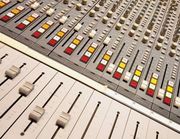3 Tips for Mixing Live Vocals

Whether you’re working the sound for a concert venue or a church that features musical performances, it is important that vocal audio comes through crisp and clear. Distortion and equalization (EQ) problems can be harsh on the ears and also make it difficult for the audience to understand what’s being sung. You will need to perform some “on-the-fly” work on your audio mixer. Use the following tips for the best outcome.
How to Mix Live Vocals Effectively
1. Find the Right Microphone
No matter how skilled you are with an audio mixer, if you’re using the wrong microphone, you’re going to face problems. Microphones are designed to impact frequency and have varying ranges. Cardioid or Supercardioid pattern microphones are ideal for singers because they’ll pick-up more of that voice and less of other singers, instruments, and monitors.
2. Make gradual changes to channel equalization.
During soundcheck, try to trim the low end from vocals to remove handling noise from the mic and low frequency instruments. You can also trim high frequencies to reduce sharp pitches. Have the user test their entire range on the sound system so you can find a balanced area from which to work.
3. Dip Into Your Toolbox
If you are working on a digital mixer, you will have a number of added audio tools to help improve sound quality. High-pass and low-pass filters can provide immediate EQing. You can decrease harsh “s” sounds with a de-esser, and a compressor can reduce the audio’s dynamic range so it’s more manageable. An audio mixer’s toolbox is invaluable when in-the-moment changes need to be made.
If you’re looking for an audio mixer or other professional gear, turn to Claiborne Sharp Professional Audio. This Shreveport, LA, store carries a wide selection of premium products. Their inventory includes video cameras and projectors, acoustic systems, sound systems, and more, all of which you can explore on their website. They also assist with audio installation, so call (318) 861-5953 today.
About the Business
Have a question? Ask the experts!
Send your question

